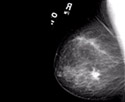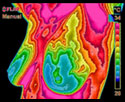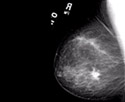What is the difference between mammography,
thermography and ultrasound?

Uses X-rays to produce an image that is a shadow of dense structures.

Uses infrared sensors to detect heat and increased vascularity (angiogenesis) as the byproduct of biochemical reactions. The heat is compiled into an image for computerized analysis.

High frequency sound waves are bounced off the breast tissue and collected as an echo to produce an image.
Additional information on all imaging can be found here.
Are there standards and guidelines under which
thermograms need to be taken?
Yes, and without them the images would be useless. The standards and guidelines under which technicians provide MIR have been in-place since the early 1980's. There are both pre-imaging protocols that patients must follow before coming in for imaging and there are also strict protocols under which the images are taken in the laboratory.
In order to prevent artifacts on the images, every patient must be provided with a list of pre-imaging instructions that must be strictly followed. The imaging room must also be designed properly and environmentally controlled within strict guidelines. The room itself should be draft free and relatively cool (68-73 degrees F) with no incandescent lighting, no heat or cooling sources near the patient, no windows without coverings, and environmentally held steady within 1 degree C during the entire time of the imaging study. In other words, you should be placed in a draft-free cool room that is very thermally stable. You will also need to spend 15 minutes acclimating to the room before imaging (nude from the waist up for breast imaging or with suitable underwear and a loose fitting gown for body imaging). And lastly, the imaging system itself must meet minimum acceptable specifications for medical use and be registered with the FDA in order to provide MIR. Without these standards in place the images would be useless. Find more information here.
Can I trust an office who has a mobile thermography service that comes in on occasion to provide imaging?
Due to the costs involved in providing MIR, some offices elect to have a mobile thermography service come in to provide imaging for their patients and/or the patients in their area. Having a standing office with a fixed imaging lab is certainly the easiest and most convenient way of meeting the standards and guidelines necessary for MIR. But this doesn't mean that mobile MIR cannot be done. Mobile MIR is perfectly acceptable as long as the standards and guidelines for imaging are not violated.
The single greatest obstacle to mobile MIR are the offices the technician is going to. Will the room and its environmental controls be in place to start the stabilization phase for the imaging system (approximately 1 hour before seeing the first patient)? Does the office ignore the temperature and draft-free requirements of the imaging room by turning on and off the AC or heat? Does this happen even if the technician has their own AC or heating unit? If the office does this, will the technician be able to work with the clinic director or owner to insure that this doesn't continue to happen? Or will the technician become frustrated, feel pressured by the presence of the patient and/or the owner of the office, and end up "bending the rules" and taking the images anyway? If this happens the patient will never know that their images were taken improperly and are useless. More information can be found here.
Learn More about Thermography
- What is Infrared Full Body Imaging
- How May Full Body Infrared Imaging Help Me?
- Is Infrared full body imaging an alternative to an MRI or CT scan
- Is full body infrared imaging safe?...and other questions
- Breast Thermography Research Studies
- Find Practitioners World-wide
- medicalinfraredimaging.com
***************************************************************************


